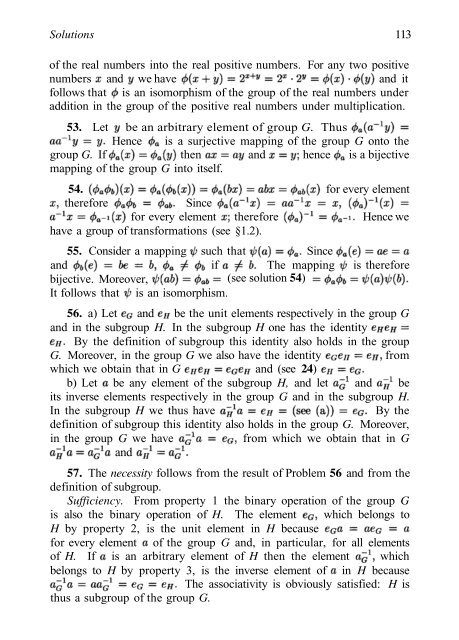Abel's theorem in problems and solutions - School of Mathematics
Abel's theorem in problems and solutions - School of Mathematics
Abel's theorem in problems and solutions - School of Mathematics
Create successful ePaper yourself
Turn your PDF publications into a flip-book with our unique Google optimized e-Paper software.
Solutions 113<br />
<strong>of</strong> the real numbers <strong>in</strong>to the real positive numbers. For any two positive<br />
numbers <strong>and</strong> we have <strong>and</strong> it<br />
follows that is an isomorphism <strong>of</strong> the group <strong>of</strong> the real numbers under<br />
addition <strong>in</strong> the group <strong>of</strong> the positive real numbers under multiplication.<br />
53. Let be an arbitrary element <strong>of</strong> group G. Thus<br />
Hence is a surjective mapp<strong>in</strong>g <strong>of</strong> the group G onto the<br />
group G. If then <strong>and</strong> hence is a bijective<br />
mapp<strong>in</strong>g <strong>of</strong> the group G <strong>in</strong>to itself.<br />
54. for every element<br />
therefore S<strong>in</strong>ce<br />
for every element therefore Hence we<br />
have a group <strong>of</strong> transformations (see §1.2).<br />
55. Consider a mapp<strong>in</strong>g such that S<strong>in</strong>ce<br />
<strong>and</strong> if The mapp<strong>in</strong>g is therefore<br />
bijective. Moreover,<br />
(see solution 54)<br />
It follows that is an isomorphism.<br />
56. a) Let <strong>and</strong> be the unit elements respectively <strong>in</strong> the group G<br />
<strong>and</strong> <strong>in</strong> the subgroup H. In the subgroup H one has the identity<br />
By the def<strong>in</strong>ition <strong>of</strong> subgroup this identity also holds <strong>in</strong> the group<br />
G. Moreover, <strong>in</strong> the group G we also have the identity from<br />
which we obta<strong>in</strong> that <strong>in</strong> G <strong>and</strong> (see 24)<br />
b) Let be any element <strong>of</strong> the subgroup H, <strong>and</strong> let <strong>and</strong> be<br />
its <strong>in</strong>verse elements respectively <strong>in</strong> the group G <strong>and</strong> <strong>in</strong> the subgroup H.<br />
In the subgroup H we thus have By the<br />
def<strong>in</strong>ition <strong>of</strong> subgroup this identity also holds <strong>in</strong> the group G. Moreover,<br />
<strong>in</strong> the group G we have from which we obta<strong>in</strong> that <strong>in</strong> G<br />
<strong>and</strong><br />
57. The necessity follows from the result <strong>of</strong> Problem 56 <strong>and</strong> from the<br />
def<strong>in</strong>ition <strong>of</strong> subgroup.<br />
Sufficiency. From property 1 the b<strong>in</strong>ary operation <strong>of</strong> the group G<br />
is also the b<strong>in</strong>ary operation <strong>of</strong> H. The element which belongs to<br />
H by property 2, is the unit element <strong>in</strong> H because<br />
for every element <strong>of</strong> the group G <strong>and</strong>, <strong>in</strong> particular, for all elements<br />
<strong>of</strong> H. If is an arbitrary element <strong>of</strong> H then the element which<br />
belongs to H by property 3, is the <strong>in</strong>verse element <strong>of</strong> <strong>in</strong> H because<br />
The associativity is obviously satisfied: H is<br />
thus a subgroup <strong>of</strong> the group G.

















